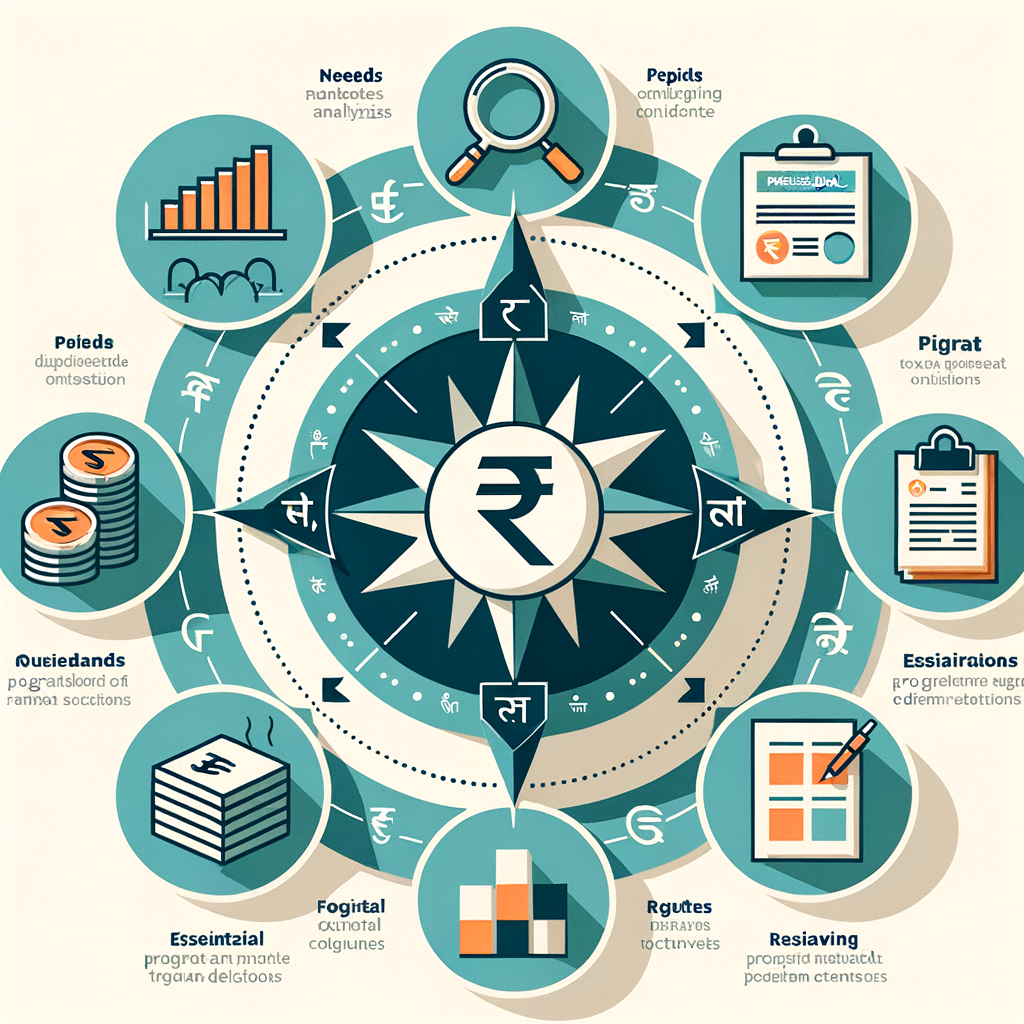Choosing the Right Debt Management Program in India: A Complete Guide
Are multiple EMIs, mounting credit card bills, and business loan repayments causing you sleepless nights? You’re not alone. Feeling overwhelmed by debt is an increasingly common experience for both dedicated salaried individuals and hardworking small business owners across India. The pressure can feel immense, but there is a clear path forward. The solution often lies in structured and effective debt management programs, which are designed to help you regain financial control and work towards a debt-free future. This comprehensive guide will walk you through the entire process of understanding, evaluating, and ultimately selecting the best plan for your unique financial situation. We will cover everything you need to know about how to choose a debt management program in India so you can make an informed and empowered decision.
What Are Debt Management Programs and Do You Need One?
Before diving into the selection process, it’s essential to have a firm grasp of what these programs entail and to honestly assess whether one is right for you. Many people mistake debt management for a quick fix or a loan, but it’s a disciplined strategy aimed at responsible repayment. Understanding this distinction is the first step towards sustainable financial health.
Defining Debt Management in the Indian Context
In the simplest terms, a debt management program is a formal arrangement, typically facilitated by a professional credit counselling agency, designed to help you methodically repay your unsecured debts. These debts commonly include high-interest obligations like credit card balances, personal loans, and outstanding medical bills. It is crucial to understand what a debt management program is not—it is not a new loan, nor is it a form of debt forgiveness or settlement where you pay back less than you owe. The core objective of debt management programs in India is to ensure you repay your original debt in full but under more manageable and less stressful terms. The agency works on your behalf to negotiate with your various creditors, often securing concessions like a lower interest rate, a waiver of late fees, or a more affordable consolidated monthly payment schedule, making your path to becoming debt-free clearer and more achievable.
5 Signs You Might Need a Debt Management Program
If you are unsure whether your financial situation warrants professional intervention, here are five clear indicators that a debt management program could be beneficial for you:
- Your Debt-to-Income Ratio (DTI) is High: If more than 40% of your gross monthly income is being used to pay off debt (excluding your home loan), you are likely over-leveraged. This high DTI ratio is a major red flag for lenders and a sign of significant financial strain.
- You Only Make Minimum Payments: Consistently paying only the minimum amount due on your credit cards means your principal balance is barely shrinking due to high interest charges. You are essentially running in place, and it could take decades to clear the debt.
- You’re Robbing Peter to Pay Paul: If you find yourself frequently using one credit card to pay off another, or taking out new personal loans to cover existing EMIs, you are caught in a dangerous debt cycle that needs to be broken.
- Collection Agents Are Calling: Once your accounts become delinquent, creditors will hand them over to collection agencies. Receiving regular calls and letters from these agents is a definite sign that your debt has become unmanageable on your own.
- Financial Stress is Affecting Your Life: Debt doesn’t just impact your bank account; it affects your mental and physical health. If you are constantly worried about money, and this stress is affecting your sleep, relationships, or performance at work, it is time to seek help.
Exploring Debt Relief Program Options in India
Before settling on a formal program, it’s important to understand the different debt relief program options India has to offer. Each approach has its own merits and is suited to different financial circumstances. Evaluating these alternatives will help you confirm whether a structured Debt Management Plan is the most appropriate choice for your specific needs or if another strategy might work better.
Debt Consolidation
Debt consolidation is a strategy where you take out a single, new loan to pay off multiple existing high-interest debts. Typically, this involves securing a personal loan from a bank or NBFC at a lower interest rate than what you are paying on your credit cards or other unsecured loans. The funds from this new loan are used to clear all your other balances, leaving you with just one loan and one EMI to manage each month.
- Pros: The primary advantage is simplification—you only have to track one payment date and one creditor. If you can secure a loan with a significantly lower interest rate, you can also save a considerable amount of money on interest charges over the life of the loan.
- Cons: Qualifying for a debt consolidation loan with a favorable interest rate requires a good credit score (typically 750 or above). Furthermore, this method does not address the underlying spending habits that led to the debt in the first place. Without a change in financial behaviour, there is a high risk of accumulating new debt on the now-cleared credit cards.
Credit Counselling
Credit counselling is an educational and advisory service that should be considered the foundational first step in any debt management journey. In this process, you work one-on-one with a certified financial counsellor from a reputable agency. The counsellor helps you perform a detailed review of your income, expenses, assets, and liabilities. Together, you create a realistic household budget, identify areas where you can cut back on spending, and learn essential money management skills. This process is focused heavily on financial education, empowering you to make better decisions and build a sustainable plan for not only repaying your current debt but also avoiding future financial pitfalls. It is often through credit counselling that a formal Debt Management Plan is recommended and initiated.
Formal Debt Management Plan (DMP)
This is the core topic and often the most structured path to becoming debt-free. A formal Debt Management Plan (DMP) is a comprehensive program administered by a credit counselling agency. After assessing your financial situation, the agency negotiates directly with your creditors on your behalf. The goal of these negotiations is to secure more favourable repayment terms, which can include a reduction in interest rates, a waiver of accumulated late fees and penalties, or an extension of the repayment period. Once an agreement is reached with your creditors, you will make a single, consolidated monthly payment directly to the counselling agency. The agency then takes on the responsibility of disbursing the appropriate amounts to each of your creditors according to the agreed-upon schedule. This approach is best suited for individuals who have multiple unsecured debts and the stable income to make regular repayments but need the structure, discipline, and negotiated benefits that a formal plan provides.
How to Choose the Best Debt Management Program: A Step-by-Step Guide
Finding the right partner to guide you out of debt is crucial for your success. The industry has many players, and not all of them have your best interests at heart. Follow these essential steps on how to choose a debt management program in India to ensure you partner with a reputable and effective agency.
Step 1: Conduct a Thorough Financial Self-Assessment
Before you can even begin to look for help, you must have a crystal-clear picture of your own financial situation. You cannot fix a problem you don’t fully understand. Start by creating a detailed list or spreadsheet of all your debts. For each debt, you must record the creditor’s name, the total outstanding balance, the current interest rate (APR), and the minimum monthly payment required. Sum these up to see your total debt burden. Next, meticulously track your total monthly income from all sources and list all your essential monthly expenses—this includes rent/mortgage, utilities, groceries, transportation, and insurance. By subtracting your total expenses from your total income, you will determine your disposable income, which is the maximum amount you can realistically allocate towards debt repayment each month. This self-assessment is non-negotiable; it provides the baseline data you will need to discuss with any potential agency and helps you gauge the feasibility of any plan they propose.
Step 2: Research and Vet Potential Agencies
With your financial data in hand, your next step is to research and identify the top debt management services in India. A simple online search is a good starting point, but your vetting process must go much deeper. Look for agencies that have been in operation for several years and employ certified credit counsellors. Read online reviews and client testimonials from multiple sources to get a sense of their reputation and success rate. A professional and trustworthy agency will be transparent about its processes and fees. During your research, be extremely cautious and watch for these major red flags:
- Unrealistic Promises: Any agency that guarantees it can eliminate or “wipe out” your debt is likely a scam. Legitimate DMPs focus on full repayment under better terms.
- High Upfront Fees: Reputable non-profit credit counselling agencies may charge a small setup fee and a monthly administrative fee, but they will not demand large payments before any services are rendered.
- Lack of Transparency: If an agency is vague about its fees, avoids putting promises in writing, or lacks a proper physical address and company registration details, you should avoid them. You can and should verify the company’s legitimacy on the official Ministry of Corporate Affairs (MCA) portal.
Step 3: Understand the Fee Structure and Agreement
Once you have shortlisted a few reputable agencies, schedule a consultation to discuss your situation. During this meeting, it is imperative that you ask for a clear and complete breakdown of all fees involved. A trustworthy agency will have no problem providing you with a written schedule of their charges, which typically includes a one-time setup fee and a small monthly maintenance or administrative fee to manage your payments. These fees should be reasonable and proportionate to the service provided. Before you commit to anything, insist on reviewing the client agreement in detail. Do not let them rush you through this process. Read every clause carefully, paying close attention to the duration of the program, the exact monthly payment amount, the payment schedule, and the agency’s cancellation policy. Ensure you understand all your obligations and rights before you sign any legally binding document.
Tailored Debt Management Strategies for Your Profile
The journey out of debt is not one-size-fits-all. The most effective strategies often depend on your primary source of income and financial structure. A salaried employee’s approach will differ from that of a small business owner, each facing unique challenges and opportunities.
Best Debt Management Tips for Indian Consumers (Salaried Employees)
For salaried individuals with a predictable monthly income, the key to successful debt management lies in discipline and smart budgeting. The consistency of your paycheck is a powerful tool when channelled correctly. Incorporating a few proven debt management strategies for salaried employees in India can dramatically accelerate your progress and build a strong foundation for future financial stability. Here are some of the best debt management tips for Indian consumers:
- Budgeting with the 50/30/20 Rule: This is a simple yet powerful framework for managing your monthly take-home pay. Allocate 50% of your income for essential needs (housing, food, utilities, transport), 30% for wants (entertainment, dining out, hobbies), and a disciplined 20% for savings and debt repayment. When in a DMP, you might need to adjust this to 50/10/40, drastically cutting ‘wants’ to accelerate debt repayment.
- The Debt Snowball or Avalanche Method: These are two popular DIY debt repayment strategies. With the Debt Snowball method, you focus on paying off your smallest debts first, regardless of the interest rate, to score quick wins and build momentum. With the Debt Avalanche method, you prioritize paying off debts with the highest interest rates first, which saves you the most money over time. Learning about Debt Snowball vs. Debt Avalanche: Which Strategy Is Best for You? will help you decide on the right approach.
- Build an Emergency Fund: One of the main reasons people fall into debt is an unexpected expense like a medical emergency or job loss. Proactively building an emergency fund that covers 3-6 months of essential living expenses creates a crucial financial buffer. This fund will prevent you from having to rely on high-interest credit cards or personal loans when life throws you a curveball. The process of Building an Emergency Fund While Managing Debt requires discipline but is essential for long-term stability.
Smart Debt Management for Small Business Owners
Small business owners face a more complex financial landscape, often juggling business liabilities with personal finances. Unpredictable cash flow and the need for working capital can easily lead to a debt spiral if not managed with foresight and discipline. A strategic approach is vital to maintain both business viability and personal financial health.
- Separate Business and Personal Finances: This is the golden rule of business finance. You must maintain separate bank accounts, credit cards, and lines of credit for your business and personal use. Co-mingling funds makes it incredibly difficult to track business profitability, manage cash flow, and can lead to serious legal and tax complications. This separation brings clarity and discipline to your financial management. A key part of this is to Set Up An Accounting System for My Small Business that is distinct from your personal accounts.
- Proactive Cash Flow Management: Don’t wait for a financial crisis to happen. Use simple accounting software to create cash flow forecasts for the next 3, 6, and 12 months. This allows you to anticipate potential shortfalls and arrange for financing or cut costs before you’re in a desperate situation. Proactive management is always cheaper and less stressful than reactive crisis control.
- Explore Business Debt Restructuring: If your business is burdened with multiple high-cost loans, look into restructuring options. This could involve consolidating several loans into a single, longer-term loan with a lower interest rate. The Indian government offers various schemes for Micro, Small, and Medium Enterprises (MSMEs) that can provide financial assistance and easier credit terms. Start by exploring the options available on the Udyam MSME Registration portal.
Conclusion
Navigating the path out of debt can feel like a monumental task, but it is an achievable goal with the right strategy and support. Choosing the right path begins with a clear-eyed understanding of your financial situation, a thorough knowledge of the available debt management programs, and a meticulous process for vetting any service provider you consider partnering with. The journey requires commitment and discipline, but the reward is immense. Whether you are a salaried professional struggling with credit card bills or a business owner managing complex liabilities, a structured approach can transform a stressful, overwhelming situation into a manageable and empowering journey toward lasting financial freedom.
Don’t let debt control your future. The experts at TaxRobo can provide the financial guidance you need to assess your options. Contact us today for a confidential consultation to find the best debt management strategy for you.
Frequently Asked Questions (FAQs)
1. Will enrolling in a debt management program in India hurt my credit score?
Initially, your credit score might see a slight dip. This happens because the credit accounts included in your plan may be closed by the creditors, or your credit report might be updated with a remark indicating you are “under a DMP.” However, this initial impact is temporary and part of a long-term healing process. By making consistent, on-time payments through the program every single month, you are building a strong, positive payment history. Over time, this consistent repayment behaviour is one of the most significant factors in improving your credit score, and it will likely recover and surpass its previous level by the time you complete the program.
2. What types of debt can be included in a DMP?
Debt Management Plans (DMPs) are specifically designed to handle unsecured debts. This category includes obligations that are not backed by any collateral. The most common types of debt included are credit card balances, unsecured personal loans, outstanding medical bills, and payday loans. It’s important to note that secured debts, such as home loans (mortgages) and car loans, are generally not included in a DMP because they are tied to a specific asset that the lender can repossess if you default on payments.
3. How is a debt management program different from debt settlement?
The primary and most critical difference between these two approaches lies in the amount you repay. In a debt management program, the goal is to repay 100% of your principal debt, often with the benefit of reduced interest rates and waived fees negotiated by the counselling agency. In contrast, debt settlement involves negotiating with your creditors to pay back only a portion of what you originally owed—a “settled” amount that is less than the full balance. While debt settlement might sound appealing, it has a much more severe and long-lasting negative impact on your credit score and can have tax implications, as the forgiven debt may be treated as taxable income.
4. How long does a typical debt management program last?
The duration of a debt management program varies for each individual, as it is tailored to their specific financial situation. However, most DMPs are structured to help you become completely debt-free within a timeframe of 3 to 5 years. The exact duration depends on two key factors: the total amount of your enrolled debt and the size of the consolidated monthly payment you can comfortably afford to make. A larger payment will naturally help you clear your debt faster.



